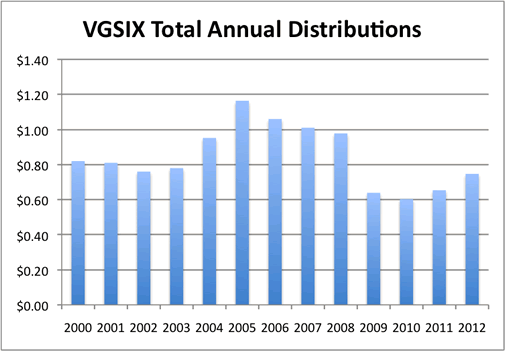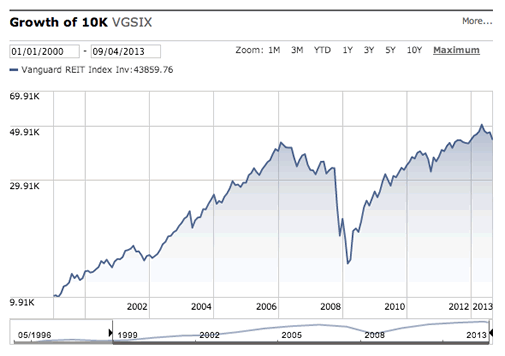The Vanguard REIT Index Fund provides low-cost, broad exposure to real estate investment trusts (REITs). It is available in mutual fund (VGSIX, VGSLX) and ETF shares (VNQ). A unique feature of this asset class is that to qualify as a REIT, a company must distribute at least 90 percent of its taxable income to its shareholders annually. This means that the income earned by this collection of commercial property (shopping malls, office buildings), self-storage companies, apartment complexes, and nursing homes is almost 100% spit out as dividends. (Note that REIT distributions don’t qualify for the preferred dividend tax rates).
I was curious as to what it would have been like to hold this fund and treat it like an income-producing rental property. Let’s say I bought it starting January 2000 and held it until today. I went on Yahoo Finance and looked up the historical distributions for VGSIX and added them up on an annual basis. Here’s what you would have earned per share:

As the share price in 2000 was about $10, you would have started with roughly an 8% annual yield. Based on that initial $10 number, your annual yield would have risen to nearly 12% in 2005 and dropped to 6% in 2010. Of course, the share price did vary over the entire period, with some big swings and ending up at over $20 today. On a total return basis (share appreciation plus dividends), this fund has shown significant volatility but has done quite well for those that held on:

I like taking the different perspective of only looking at the dividends being generated. Would it have been easier to hold onto this fund through the financial crisis if I was focused primarily on income? It definitely seems less crazy, but I would’ve still been worried at the time.
 The Best Credit Card Bonus Offers – 2025
The Best Credit Card Bonus Offers – 2025 Big List of Free Stocks from Brokerage Apps
Big List of Free Stocks from Brokerage Apps Best Interest Rates on Cash - 2025
Best Interest Rates on Cash - 2025 Free Credit Scores x 3 + Free Credit Monitoring
Free Credit Scores x 3 + Free Credit Monitoring Best No Fee 0% APR Balance Transfer Offers
Best No Fee 0% APR Balance Transfer Offers Little-Known Cellular Data Plans That Can Save Big Money
Little-Known Cellular Data Plans That Can Save Big Money How To Haggle Your Cable or Direct TV Bill
How To Haggle Your Cable or Direct TV Bill Big List of Free Consumer Data Reports (Credit, Rent, Work)
Big List of Free Consumer Data Reports (Credit, Rent, Work)
Interesting article. I am going through a similar decision making process currently. I have had an unexpected windfall and was thinking about buying some rental properties with it to generate a passive income stream. Then I thought why not just by REITs, gain a similar yield with less work?
I view any investment where I don’t have as much control to be more risky, but is it really?
Curious if others have faced a similar situation.
Hi Jonathan,
You are assuming the best, which is “As the share price in 2000 was about $10″… what if you bought it at 2006, what’s the return then? Not so good. As we all experienced in 2008, REITs are subject to the same market volatility, not as safe/recession proof as most people think.
Buy low sell high, and you’ll do good in any investments. 🙂
That’s why folks like Swensen (Yale) recommend such a large allocation to them. Great diversifiers that are somewhat inflation protected as REITs can raise rents.
Nice article, thanks Jonathan. I was trying to translate those numbers pretending VGSIX was rental property. I was using a scenario where someone bought at the worst time, the peak in 2007. Am I doing it right?
Purchase in 2007: $280,000 (equivalent to 10,000 shares VGSIX)
Here’s what the annual “net income” would be. I’m defining “net income” as income minus expenses, excluding tax and depreciation.
2007 $10,000
2008 $9,500
2009 $6,500
2010 $6,000
2011 $6,500
2012 $7,500
Pretty much. Here are the numbers per share:
2000 $0.82
2001 $0.81
2002 $0.76
2003 $0.78
2004 $0.95
2005 $1.16
2006 $1.06
2007 $1.01
2008 $0.98
2009 $0.64
2010 $0.60
2011 $0.65
2012 $0.75
I often think about this but I often go back to physical property. Think of this (especially for us California folks)…….
Wen investing long term, imagine what happens to the physical property when it is fully paid and you are holding deed in hand! And then don’t forget about prop 13 protection here in Cali where you can charge market rate rent while enjoying protected annual property taxes!
I have a bro in law who acquired many 2nd gen properties who is reaping HUGE rewards from that very idea. You have to think VERY long term, but there is enough income now for him to live like a king and it will only get better.
REIT’s can’t do that.
Red’s post reminded me that I forgot about the mortgage factor. My “net income” numbers would only be equivalent to buying the rental property with all cash, no mortgage. If you were to finance the property, assuming some typical numbers like 20% down pay, 4% interest rate, you would be paying $280,000 * 80% * 4% ~= $9000 per year in interest in the early years. So you’d be in the red from 2009-2012.
Curious what the return would be like of the fund versus the ETF with the difference in fees. I would look up myself but a little short on time.